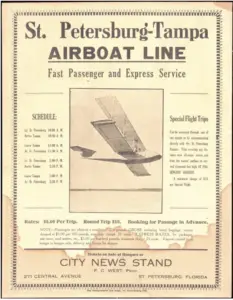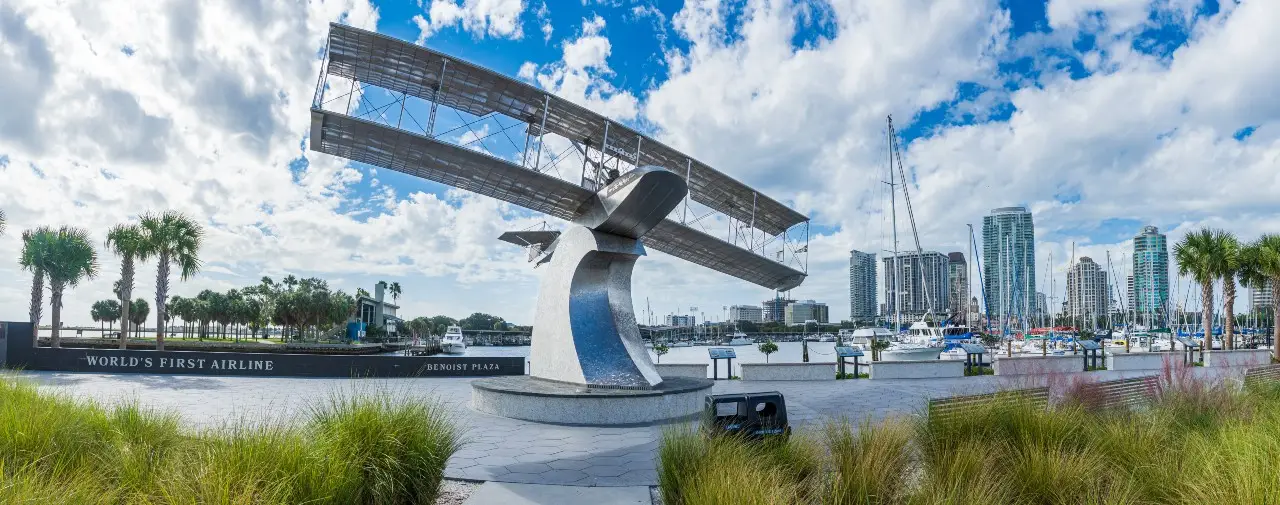January 1914- Florida passengers board the first commercial flight
Someday people will be crossing oceans on airliners like they do on steamships today- Thomas Benoist
The vision
Florida salesman Percival Elliott Fansler was eager to establish a commercial airline. He proposed aviator Thomas W. Benoist’s aircraft (capable of landing and taking off in water) would be perfect for an airline between St. Petersburg and Tampa.
The aircraft
The model 14 Benoist airboat was a 26-foot long bi-plane weighing 1,250 pounds. It was capable of traveling 125 miles at 64 mph. The hull was constructed of three layers of spruce with fabric between each layer. The wings were spruce spars with linen stretched over them. A passenger could sit next to the pilot on a single wooden seat.
The dashing pilot
The pilot chosen for the job was Anthony (Tony) Jannus. His resume included flying exhibitions, testing military planes, and flying long-distance airplanes and airboats. He also piloted the first test of airborne machine guns and was the pilot of the first parachute jump from an aircraft. He achieved celebrity status and was a media spectacle of his time.
The big day
 On New Year’s Day, 1914, approximately 3,000 people and an Italian band gathered at the St. Petersburg waterfront to witness the momentous occasion. The first passenger ticket was auctioned off to warehouse businessman and former St. Petersburg Mayor, Abram C. Pheil. He won with a bid of $400 -more than $11,000 today.
On New Year’s Day, 1914, approximately 3,000 people and an Italian band gathered at the St. Petersburg waterfront to witness the momentous occasion. The first passenger ticket was auctioned off to warehouse businessman and former St. Petersburg Mayor, Abram C. Pheil. He won with a bid of $400 -more than $11,000 today.
Before the flight, Fansler was quoted by the Tampa Bay Times as having said, “What was impossible yesterday is an accomplishment today, while tomorrow heralds the unbelievable.” Just a decade after Orville and Wilbur Wright had made their first flights, the airboat took flight to a cheerful crowd waving them on.
The flight
Normally a 20-hour trip by automobile, 2 hours by steamship, or 4-12 hours by rail, a flight from St. Petersburg to Tampa, Fla was just around 20 minutes. The airline would make two flights daily, six days a week. A one-way ticket cost $5 per person (nearly $140 today) and $5 per 100 pounds of freight. Tickets sold out 16 weeks in advance.
There were two Benoist Type XIVs, both purchased by the St. Petersburg Tampa Airboat Lines. They were named Lark of Duluth and Florida. Over the next three months, the two flying boats carried more than 1,000 passengers logging more than 11,000 miles. With the addition of the second aircraft, flights were extended to Sarasota, Bradenton, and Manatee. Tony Jannus’ brother, Roger, was the second pilot. With no windshield and so close to the water, these first commercial flights were windy and wet but nonetheless, a welcome time-saver to passengers of the time.
Their legacy
After fulfilling their contract, the brothers continued to give exhibitions, perform tests, and train other pilots. On Oct. 12, 1916, Tony Jannus perished when his plane crashed into the Black Sea. In 1964, the Tampa and St. Petersburg Chambers of Commerce established the Tony Jannus Distinguished Aviation Society in honor of Tony Jannus.
A replica of the historic Benoist No. 14 (as well as other historical items from the flight,) is on display in the Benoist Pavilion at the St. Petersburg Historical and Flight One Museum. A plaque dedicated on Oct. 12, 1957, by Pinellas County reads: Here, in this county, Thomas W. Benoist, pioneer airplane builder, first proved to the world that the amazing new invention, the flying machine, could be put to work for the benefit of mankind.


